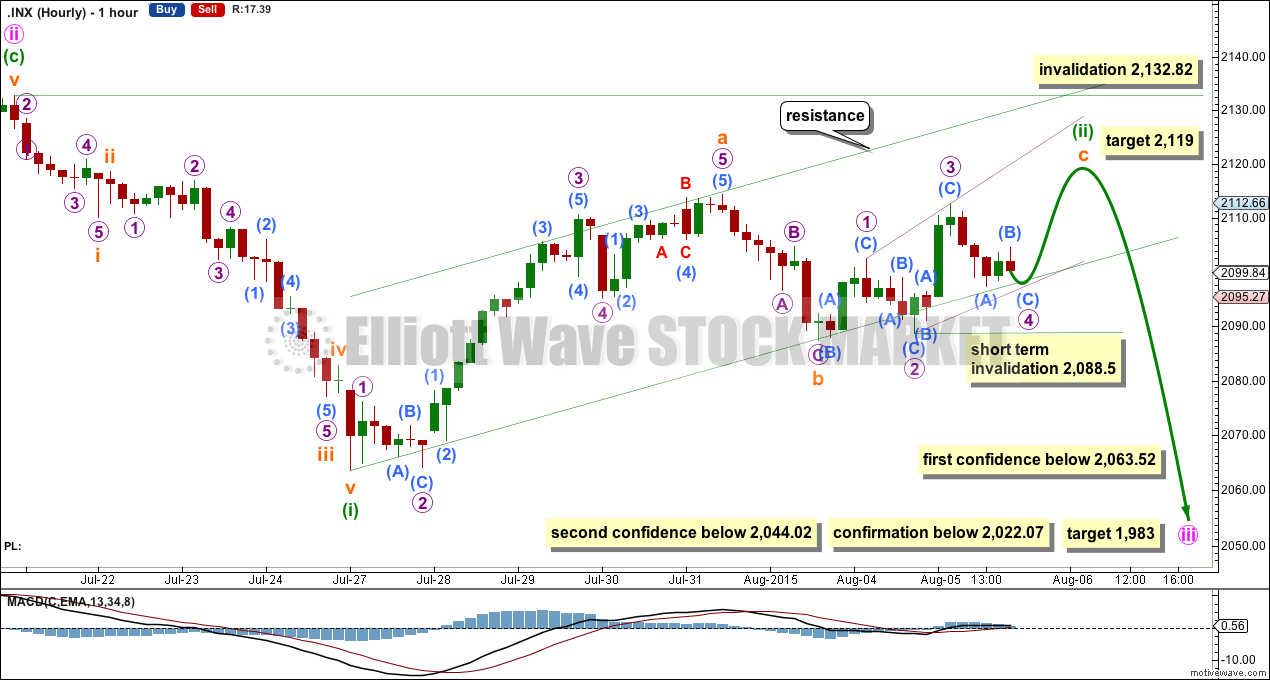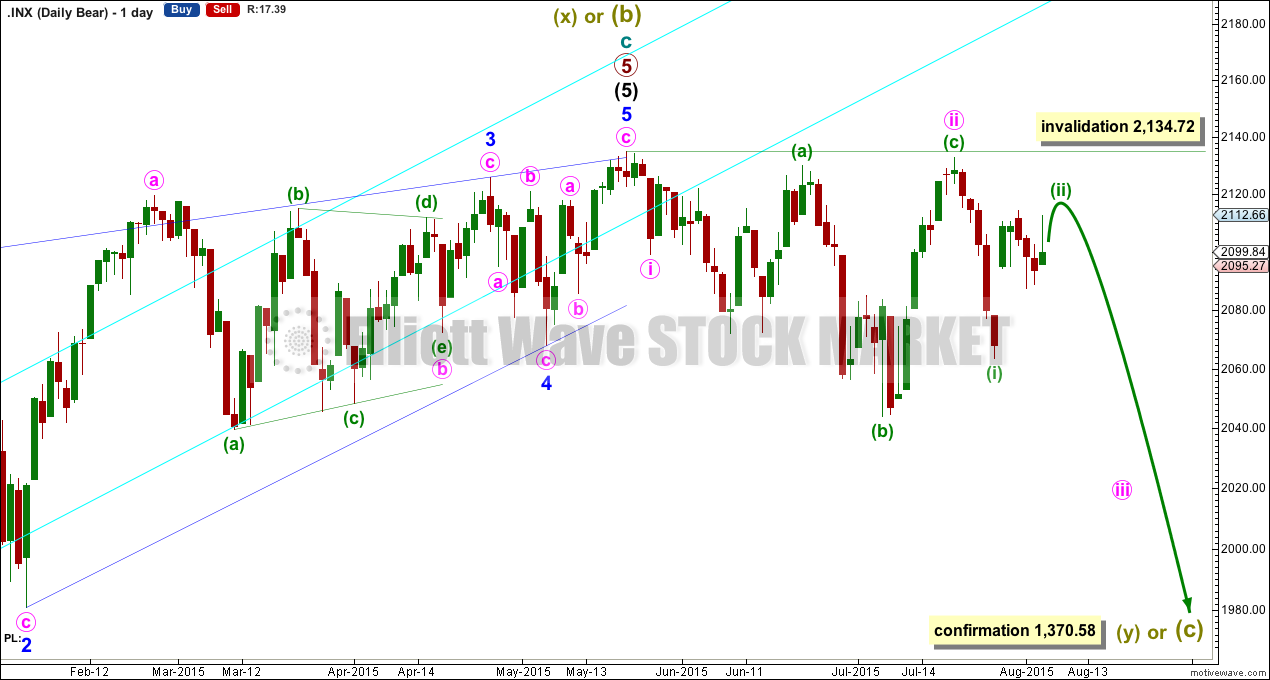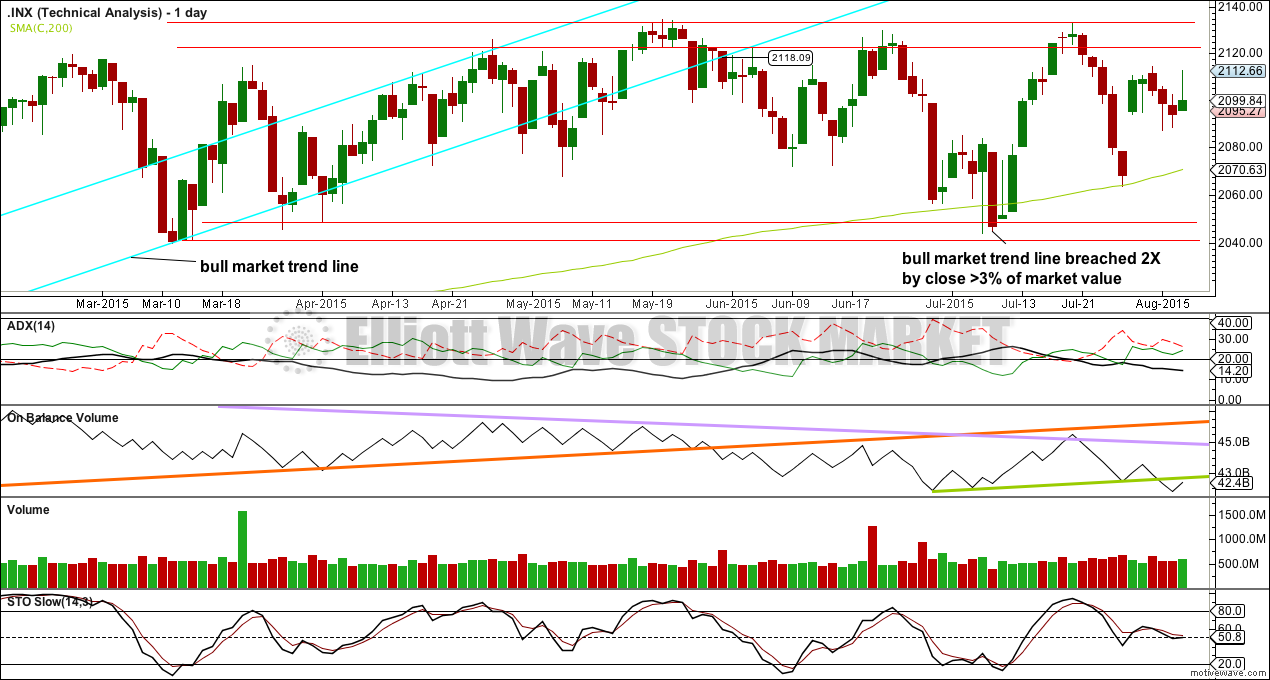A little upwards movement was expected for Wednesday’s session, which is exactly what happened.
Summary: The first wave count still expects a little more upwards movement to a target at 2,119. The second wave count expects the upwards trend to continue. If price rises above 2,132.82, then the first wave count would be invalidated and the second wave count would be confirmed. To the downside, a new low below 2,063.52 is required for some confidence in the first wave count.
Changes to last analysis are bold.
To see a weekly chart and how to draw trend lines click here.
Note regarding data for 28th July session: I am still unable to get the Google / Yahoo data feed to provide that candlestick; it remains MIA. For today’s analysis, I am relying on the candlestick on daily charts published here.
FIRST ELLIOTT WAVE COUNT
It is possible that the S&P has seen a primary degree (or for the bear count below a Super Cycle degree) trend change.
If primary wave 3 is over then primary wave 4 should begin.
Primary wave 2 was a relatively shallow 0.41 zigzag lasting 12 weeks. Primary wave 4 may be more shallow and is most likely to be a flat, combination or triangle. It may be longer lasting than primary wave 2 as these types of sideways corrective structures tend to be more time consuming than zigzags. Primary wave 4 is likely to end in the price territory of the fourth wave of one lesser degree between 1,730 – 1,647. It may last about 13 or maybe even 21 weeks. So far it has completed its tenth week.
This wave count now has some confirmation at the daily chart level with a close more than 3% of market value below the long held bull market trend line.
Further confirmation would come with:
1. A new low below 2,044.02.
2. A new low below 2,022.07 to invalidate the second wave count.
3. A clear five down on the hourly chart.
4. A clear five down on the daily chart.
5. A new low below 1,820.66.
6. A break below the 50 week SMA on the weekly chart or the 200 day SMA on the daily chart.
As each condition is met the probability of a substantial trend change would increase.
At this stage, a trend change is looking somewhat likely so I’ll list points in its favour:
1. The long held bull market trend line, the strongest piece of technical analysis on ALL charts, has been breached now by a close more than 3% of market value.
2. There is quadruple negative divergence between price and MACD on the weekly chart.
3. There is double negative divergence between price and MACD on the daily chart.
4. There is persistent and strong negative divergence between price and RSI on the monthly chart. The last time this happened was October 2007 and we all know what happened after that…
5. A long held bull trend line on On Balance Volume going back to October 2014 has been breached, is no longer providing support, and is now providing resistance.
6. DJT has recently failed to confirm the continuation of a bull market. This does not indicate a bear market, but does indicate caution.
A target for minute wave iii is added now to the daily chart and explained below. Minute wave iii should show its subdivisions clearly on the daily chart so that when it is done it has a clear five wave impulse look to it. So far minuette wave (ii) shows up clearly. When it arrives minuette wave (iv) should also show up clearly. Minuette wave (iii) should show a strong increase in downwards momentum.
At the five minute chart level, while the upwards waves labelled micro waves 1 and 3 fit perfectly as impulses, they may also fit as zigzags. There is enough overlapping within subminuette wave c now to suggest it may be unfolding as a diagonal. In the short term, micro wave 4 should move slightly lower to complete a zigzag, and may not move below the end of micro wave 2 at 2,088.50. Micro wave 4 needs to move slightly lower in order for the diagonal trend lines to clearly diverge; to label it over at Wednesday’s low would not see the trend lines diverge, so the structure would not meet the rules for an expanding ending diagonal.
Subminuette wave c may be an ending expanding diagonal. The final fifth wave up may end in one or two more days. The target remains the same, at 2,119, where subminuette wave c would reach 0.618 the length of subminuette wave a.
Minuette wave (ii) may not move beyond the start of minuette wave (i) above 2,132.82.
When minuette wave (ii) is finally over, then a strong third wave within a third wave down may be ready to begin.
At 1,983 minute wave iii would reach 4.236 the length of minute wave i. Along the way down, as each confidence price point is passed, the alternate possibilities which expect a continuation of a bull market will reduce, so the probability of a bear market will increase.
SECOND ELLIOTT WAVE COUNT
The ending contracting diagonal may still be incomplete. Ending diagonals require all sub waves to subdivide as zigzags, and the fourth wave should overlap first wave price territory. It is Elliott wave convention to always draw the diagonal trend lines to indicate a diagonal structure is expected.
My labelling here of minute wave iv within the diagonal as a double zigzag relies upon the interpretation of “double and triple zigzags take the place of zigzags” (“Elliott Wave Principle” by Frost and Prechter, 10th edition, page 91) to be true for zigzags within diagonals. This wave down may also be labelled as a single zigzag, but that does not have as neat a fit as a double zigzag.
The diagonal trend lines are no longer clearly converging. This reduces the probability of this wave count.
If it moves any lower, then minute wave iv may not be longer than equality in length with minute wave ii at 2,022.07. If it is over here, then minute wave v up also has a limit and may not be longer than equality with minute wave iii at 2,197.84.
The best way to see where and when upwards movement may end is the upper diagonal i-iii trend line. It is very likely to be overshot.
Both wave counts expect upwards movement tomorrow and maybe also the day after. This second wave count expects a third wave up to unfold. At 2,169 subminuette wave iii would reach 1.618 the length of subminuette wave i.
Along the way up, a new high above 2,132.82 would invalidate the first wave count and confirm this second wave count.
The channel drawn here is a base channel. Along the way up, this second wave count expects downwards corrections to find support at the lower edge of this channel. If this channel is clearly breached by downwards (not sideways) movement, then that would strongly favour the first wave count over this second wave count.
I am removing the final target for now. It no longer expects a reasonable overshoot of the upper pink i-iii diagonal trend line (seen on the daily chart). When there is more structure within minuette wave (c), then I will calculate the target again towards the end of this movement at subminuette wave degree. Specifically, when subminuette waves iii and iv are complete, then the target can be calculated.
BEAR ELLIOTT WAVE COUNT
The subdivisions within cycle waves a-b-c are seen in absolutely exactly the same way as primary waves 1-2-3 for the main wave count.
In line with recent Grand Super Cycle wave analysis, I have moved the degree of labelling for the bear wave count all up one degree.
This bear wave count expects a Super Cycle wave (c) to unfold downwards for a few years, and if it is a C wave it may be devastating. It may end well below 666.79.
However, if this wave down is a Super Cycle wave (y), then it may be a time consuming repeat of the last big flat correction with two market crashes within it, equivalent to the DotCom crash and the recent Global Financial Crisis, and it may take another 8-9 years to unfold sideways.
Within the new bear market, no second wave correction may move beyond the start of its first wave above 2,134.72.
The second wave count above works in the same way for this bear wave count.
TECHNICAL ANALYSIS
ADX is below 20 and declining. ADX indicates there is no clear trend and the market is consolidating. Recently rises in price are accompanied by ADX indicating no trend, and the last two falls in price were accompanied by ADX indicating the early stages of a trend (which was down) at least at the end. Overall it does look like a downwards trend may be developing, and there is at least no indication from ADX that an upwards trend may be still in place.
A range bound trading system may be better used than a trend following system. This would still expect some more downwards movement, to not end until price finds support at the lower two red horizontal trend lines and Stochastics is oversold at the same time, or to end when price finds support at the 200 day DMA and Stochastics is oversold at the same time.
On Balance Volume has broken below its short green trend line, another bearish indicator. OBV is now turning up for a throwback to that line, and this should now provide resistance. OBV expects the trend is down at least in the short term.
Along the way down, price may again find support about the 200 day SMA (green). If price breaks clearly below that line, then it would be a very bearish indicator; a bounce at least or an end to downwards movement should initially be expected there.
Wednesday’s green candlestick comes on relatively light volume. Although volume is very slightly stronger than the two prior down days, it is still weaker than the down day four days ago. This indicates a small short term consolidation may be ending.
A note on Dow Theory: for the bear wave count I would wait for Dow Theory to confirm a huge market crash. For that to be confirmed the following new lows are needed:
S&P500: 1,820.66
Nasdaq: 4,116.60
DJT: 7,700.49
DJIA: 15,855.12
At this time DJT is closest, but none of these indices have made new major swing lows yet.
This analysis is published about 10:51 p.m. EST.







Hi Lara, so on the first wave count we are making an expanding diagonal triangle for wave C of minnuete wave 2?
And if that’s the case, then you should be expecting the market yo go down hard next week?
Thanks
That is what I was expecting yes, until price broke below 2,088.60 today invalidating the ending diagonal.
It looks like subminuette wave b is moving lower as a flat correction.
I’ll still be expecting subminuette wave c to make a new high above the end of a at 2,114.24 to avoid a truncation. Only when that is done will I expect this second wave correction to finally be over.
So now it is taking it’s time, and it may not end until the end of next week.